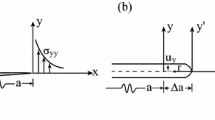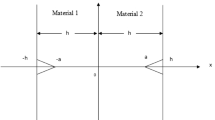Abstract
The stress fields near the tip of a matrix crack terminating at and perpendicular to a planar interface under symmetric in-plane loading in plane strain are investigated. The bimaterial interface is formed by a linearly elastic material and an elastic power-law creeping material in which the crack is located. Using generalized expansions at the crack tip in each region and matching the stresses and displacements across the interface in an asymptotic sense, a series asymptotic solution is constructed for the stresses and strain rates near the crack tip. It is found that the stress singularities, to the leading order, are the same in each material; the stress exponent is real. The oscillatory higher-order terms exist in both regions and stress higher-order term with the order of O(r°) appears in the elastic material. The stress exponents and the angular distributions for singular terms and higher order terms are obtained for different creep exponents and material properties in each region. A full agreement between asymptotic solutions and the full-field finite element results for a set of test examples with different times has been obtained.
Similar content being viewed by others
References
Bassani, J. L. and McClintock, F. A. (1981). Creep Relaxation of stress around a crack tip. International Journal of Solids Structures 17, 479–492.
Bhatt, R. T. and Philips, R. E. (1988). Laminate Behavior of SiC Fiber Reinforced Reaction Bonded Silicon Nitride Composite. NASA TM 101350.
Cannon, R. W. and Langdon, T. G. (1983), Review: Creep of Ceramics. Journal of Materials Science 23, 1–50.
Chen, J. L. and Sun, C. T. (1988). Modeling of Creep Behavior of SiC Fiber Composites. Proceedings of the American Society for Composites, Third Technical Conference, Seattle, Washington, pp. 564–574.
Dicarlo, J. A. (1986). Creep of Chemically Vapour Deposited SiC Fibers. Journal of Materials Science 21, 217–224.
Ehlers, R. and Reidel, H. (1981). A finite element analysis of creep deformation in a specimen containing a macroscopic crack. Advances in Fracture Research, Vol. 2, The Fifth International Conference on Fracture, (Edited by D. Francois), Cannes, pp. 691–698.
Hill, B. B., Bakis, C. E. and Hahn, H. T. (1992). Creep of SiC/RBSN Composite: Analytical Modeling, MDVol. 40, Constitutive Behavior of High-Temperature Composites, ASME, (Edited by B. S. Majumdar et al.), 121–135.
Holmes, J. W. (1991). Tensile Creep Behavior of a Hot-Presses SiC Fiber-Reinforced Si3N4 Composite. Journal of Materials Science 26, 1801–1814.
Hui, C.-Y. and Reidel, H. (1981). The asymptotic stress and strain field near the tip of growing crack under creep conditions. International Journal of Fracture 17(4), 409–425.
Hui, C.-Y. (1983). Steady-state crack growth in elastic power-law creeping materials. Elastic-Plastic Fracture: Second Symposium, Vol. I. Inelastic Crack Analysis, ASTM STP 803, American Society for Testing and Materials (Edited by Shih, C. F. and Gudas, J. P.), pp. 573–593.
Hui, C.-Y. and Saif, M. T. A. (1994). Asymptotic stress field of a mode III crack growing along an elastic/elastic power-law creeping bimaterial interface. Journal of Applied Mechanics 61, 384–389.
Hutchinson, J. W. (1968). Singular behavior at the end of a crack in a hardening material. Journal of Mechanics Physics Solids 16(1), 13–31.
Jablonski, D. A. and Bhatt, R. T. (1990). High-Temperature Tensile properties of Fiber Reinforced Reaction Bonded Silicon Nitride. Journal of Composites Technology and Research 12(3), 139–146.
Kelly, A. (1982). Composite Principles. Fatigue and Creep of Composite Materials, 3 rd RisøInternational Symposium on Metallurgy and Materials Science (Edited by Lilholt, H. and Talreja, R.), 51–62.
Li, Y. and Wang, Z. (1986). Higher-order asymptotic field of tensile plane-strain nonlinear crack problems. Scientia Sinica (series A) XXIX (9), 941–955.
Mah T. et al. (1985). High-Temperature Mechanical Behavior of Fiber-Reinforced Glass Ceramic Matrix Composites. Journal of American Ceramic Society 68 (9), C248–251.
Pagano, N. J. and Brown, H. W., III. (1993), The Full-Cell Cracking Mode in Unidirectional Brittle-Matrix Composites. Composites 24 (2), 69–83.
Park, Y. H. and Holmes, J.W. (1992). Finite ElementModeling of Creep Deformation in Fiber-Reinforced Ceramic Composites. Journal of Materials Science 27, 6341–6351.
Reidel, H. (1978). Cracks loaded in anti-plane shear under creep conditions. Zeitschrift für Metallkunde 69, 755–760.
Reidel, H. and Rice, J. R. (1980). Tensile cracks in creeping solids. Fracture Mechanics: Twelfth Conference, ASTM STP 700, 112–130.
Rice, J. R. and Rosengren, G. F. (1968). Plane strain deformation near a crack tip in a power-law hardening material. Journal of Mechanical Physics Solids 16 (1), 1–12.
Wang, C. T. (1990). Elastic-plastic asymptotic fields for cracks on bimaterial interfaces. Engineering Fracture Mechanics 37 (3), 527–538.
Yang, S. Chao, Y. J. and Sutton, M. A. (1991). Higher order asymptotic crack tip fields in a power-law hardening materials. Engineering Fracture Mechanics 45 (1), 1–20.
Yang, S. Yuan, F. G. and Cai, X. (1996). Higher order asymptotic elastic-plastic crack-tip fields under antiplane shear. Engineering Fracture Mechanics 54 (3), 405–422.
Yuan, F. G. and Yang, S. (1997). Crack-Tip Fields in Elastic-Plastic Material under Plane Stress Mode I Loading. International Journal of Fracture 85 (2), 131–155.
Author information
Authors and Affiliations
Rights and permissions
About this article
Cite this article
Yuan, F., Yang, S. Crack-tip fields for matrix cracks between dissimilar elastic and creeping materials. International Journal of Fracture 103, 327–360 (2000). https://doi.org/10.1023/A:1007620114187
Issue Date:
DOI: https://doi.org/10.1023/A:1007620114187




